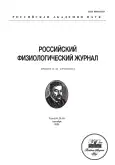Analysis of Relaxation Phase in the Rat Heart
- Authors: Kapelko V.I.1, Abramov A.A.1, Lakomkin V.L.1
-
Affiliations:
- National Medical Research Center of Cardiology, Ministry of Healthcare, Russian Federation
- Issue: Vol 109, No 10 (2023)
- Pages: 1489-1497
- Section: EXPERIMENTAL ARTICLES
- URL: https://journals.rcsi.science/0869-8139/article/view/232288
- DOI: https://doi.org/10.31857/S0869813923100060
- EDN: https://elibrary.ru/VBONMG
- ID: 232288
Cite item
Full Text
Abstract
The rate and depth of myocardial relaxation determine left ventricular (LV) filling in early diastole. To analyze the relaxation phase, the method of logarithm of LV pressure fall in rats was used. A gradual acceleration of relaxation was found during the transition from the isovolumic phase to the auxovolumic phase, immediately before the opening of the atrioventricular valves. The relaxation rate constant in this phase has been inversely correlated with the values of the minimum LV diastolic pressure and LV endsystolic volume. The results suggest that the gradual acceleration of relaxation is due to the straightening of the spring-like structure of connectin (titin), which is compressed during contraction.
Keywords
About the authors
V. I. Kapelko
National Medical Research Center of Cardiology, Ministry of Healthcare, Russian Federation
Email: v.lakomkin@yandex.ru
Russia, Moscow
A. A. Abramov
National Medical Research Center of Cardiology, Ministry of Healthcare, Russian Federation
Email: v.lakomkin@yandex.ru
Russia, Moscow
V. L. Lakomkin
National Medical Research Center of Cardiology, Ministry of Healthcare, Russian Federation
Author for correspondence.
Email: v.lakomkin@yandex.ru
Russia, Moscow
References
- Janssen PML (2019) Myocardial relaxation in human heart failure: Why sarcomere kinetics should be center-stage. Arch Biochem Biophys 661: 145–148. https://doi.org/10.1016/j.abb.2018.11.011
- Bukowski MJ, Cavanaugh B, Abbo A, Chung CS (2023) Mechanical Control of Relaxation using Intact Cardiac Trabeculae. J Vis Exp 17: 192. https://doi.org/10.3791/64879
- Eisner DA, Caldwell JL, Trafford AW, Hutchings DC (2020) The Control of Diastolic Calcium in the Heart: Basic Mechanisms and Functional Implications. Circ Res 126: 395–412. https://doi.org/10.1161/CIRCRESAHA.119
- Biesiadecki BJ, Davis JP, Ziolo MT, Janssen PML (2014) Tri-modal regulation of cardiac muscle relaxation; intracellular calcium decline, thin filament deactivation, and cross-bridge cycling kinetics. Biophys Rev 6(3-4): 273–289. https://doi.org/10.1007/s12551-014-0143-5
- Langer SF, Schmidt HD (2003) Influence of preload on left ventricular relaxation in isolated ejecting hearts during myocardial depression. Exp Clin Cardiol 8: 83–90.
- Janssen PML, Stull LB, Marban E (2002) Myofilament properties comprise the rate-limiting step for cardiac relaxation at body temperature in the rat. Am J Physiol Heart Circ Physiol 282: H499–H507. https://doi.org/10.1152/ajpheart.00595.2001
- Zile MR, Baicu CF, Gaasch WH (2004) Diastolic heart failure–abnormalities in active relaxation and passive stiffness of the left ventricle. N Engl J Med 350: 1953–1959. https://doi.org/10.1056/NEJMoa032566
- Meerson FZ, Kapelko VI (1975) The significance of the interrelationship between the intensity of the contractile state and the velocity of relaxation in adapting cardiac muscle to function at high work load. J Mol Cell Cardiol 7(11): 793–806. https://doi.org/10.1016/0022-2828(75)90131-5
- Weiss JL, Frederiksen JW, Weisfeldt ML (1976) Hemodynamic determinants of the time-course of fall in canine left ventricular pressure. J Clin Invest 58: 751–760. https://doi.org/10.1172/JCI108522
- Капелько ВИ, Горина МС (1987) Кальциевая регуляция сокращения и расслабления миокарда. B кн: Регуляция сократительной функции и метаболизма миокарда. М. Наука. 79– 112. [Kapel’ko VI, Gorina MS (1987) Calcium regulation of myocardial contractility function and myocardial relaxation. In: Regulation of contractile function and myocardial metabolism. M. Nauka. 79–112. (In Russ)].
- DeSantiago J, Maier LS, Bers DM (2002) Frequency-dependent acceleration of relaxation in the heart depends on CaMKII, but not phospholamban. J Mol Cell Cardiol 34(8): 975–984. https://doi.org/10.1006/jmcc.2002.2034
- Vitale G, Ferrantini C, Piroddi N, Scellini B, Pioner JM, Colombini B, Tesi C, Poggesi C (2021) The relation between sarcomere energetics and the rate of isometric tension relaxation in healthy and diseased cardiac muscle. J Muscle Res Cell Motil 42: 47–57. https://doi.org/10.1007/s10974-019-09566-2
- Langer SFJ (2002) Differential laws of left ventricular isovolumic pressure fall. Physiol Res 51(1): 1–15.
- Капелько ВИ, Новикова НА (1986) Изо- и ауксово-объемные константы расслабления сердца при оценке его инотропизма. Бюлл Всесоюзн кардиол научн центра АМН СССР 1: 37–45. [Kapel’ko VI, Novikova NA (1986) Isovolumic and auxovolumic constants of cardiac relaxation in evaluating its inotropism. Biull Vsesoiuz Kardiol Nauchn Tsentra AMN SSSR 1: 37–45. (In Russ)].
- Orlova TsR, Kapel’ko VI (1986) Rate constants of left ventricular relaxation: the effect of inotropic and mechanical factors. Cardiology 26(6): 79–83.
- Katz LN (1930) The role played by the ventricular relaxation process in filling the ventricle. Am J Physiol 95: 542–553. https://doi.org/10.1152/ajplegacy.1930.95.3.542
- Brecher GA (1956) Experimental evidence of ventricular diastolic suction. Circ Res 4: 513–518. https://doi.org/10.1161/01.res.4.5.513
- Helmes M, Trombitás K, Granzier H (1996) Titin develops restoring force in rat cardiac myocytes. Circ Res 79: 619–626. https://doi.org/10.1161/01.res.79.3.619
- Preetha N, Yiming W, Helmes M, Fukuda N, Labeit S, Granzier H (2005) Restoring force development by titin/connectin and assessment of Ig domain unfolding. J Muscle Res Cell Motil 26: 307–317. https://doi.org/10.1007/s10974-005-9037-2
- Hidalgo C, Hudson B, Bogomolovas J, Zhu Y, Anderson B, Greaser M, Labeit S, Granzier H (2009) PKC phosphorylation of titin’s PEVK element: a novel and conserved pathway for modulating myocardial stiffness. Circ Res 105: 631–638. https://doi.org/10.1161/CIRCRESAHA.109.198465
- Chen M-P, Kiduko SA, Saad NS, Canan BD, Kilic A, Mohler PJ, Janssen PML (2020) Stretching single titin molecules from failing human hearts reveals titin’s role in blunting cardiac kinetic reserve. Cardiovasc Res 116: 127–137. https://doi.org/10.1093/cvr/cvz043
- Cazorla O, Freiburg A, Helmes M, Centner T, McNabb M, Wu Y, Trombitás K, Labeit S, Granzier H (2000) Differential expression of cardiac titin isoforms and modulation of cellular stiffness. Circ Res 86: 59–67.https://doi.org/10.1161/01.res.86.1.59
Supplementary files














